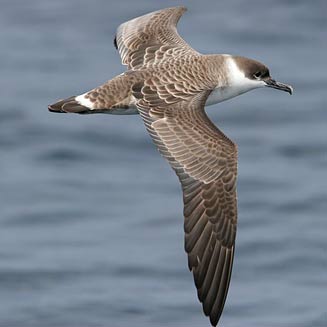
Great Shearwater at sea
Paloma Carvalho (Department of Biological Sciences, University of Manitoba, Winnipeg, Canada) and colleagues have published open access in the journal Marine Ornithology on foraging behaviour of Great Shearwaters gravis and Sooty A. grisea Shearwaters off Newfoundland.
The paper’s abstract follows:
“Species tend to concentrate in areas with high prey availability, which could lead to competitive interactions within a feeding assemblage as resources become depleted. In coastal Newfoundland, Canada, capelin Mallotus villosus is the focal forage fish species that many top predators feed on during the summer; however, inshore availability varies throughout the boreal summer when abundant aggregations migrate inshore to spawn. We investigated the interactions and responses of Great Shearwaters Ardenna gravis and Sooty Shearwaters A. grisea during their non-breeding season to supplemental food supply under changing natural prey availability (higher and lower capelin availability) by conducting an at-sea experiment during July-August (2015/2016) in coastal Newfoundland. Supplemental food was offered every 30 s over 10 min (‘experimental period'), which was preceded and followed by 10-min control periods (i.e., no food provided). The number of both species increased during the experimental periods, indicating that both species were attracted to the food supplementation experiment. Great Shearwaters were 7.6-13.8 times more likely than Sooty Shearwaters to land near the experimental platform and 95.2 times more likely than Sooty Shearwaters to fight over supplemental food items with individuals of the same or different species. These species-specific tendencies remained consistent as prey availability varied within years, but both species increased in their abundance and interactions with other species (including Herring Gulls Larus argentatus and Northern Fulmars Fulmarus glacialis) during prey capture at lower relative to higher prey availability, as evidenced by lower proportions of flying birds and a greater likelihood of landing on the water. Overall, we suggest that when Great and Sooty shearwaters feed in close association, Great Shearwaters are the more competitively dominant species, which may lead to higher risks of by-catch mortality, especially when the availability of natural prey decreases.”
Reference:
Carvalho, P.C., Maynard, L.D. & Davoren, G.K. 2020. Responses of sympatric shearwaters to supplemental food under varying natural prey availability on the wintering grounds of coastal Newfoundland, Canada. Marine Ornithology 48: 255-262.
John Cooper, ACAP Information Officer, 28 September 2020

 Español
Español  English
English  Français
Français